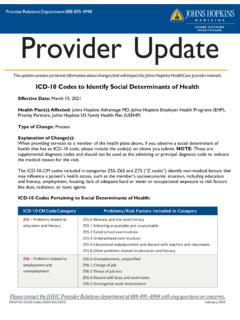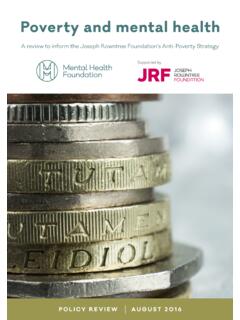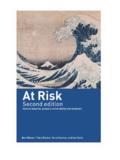Transcription of Human Health and the Environment - OECD
1 OECD 200121 Human Health andthe IntroductionConcern for Health has traditionally underlain much of the political priority given to environmental issues inOECD countries. The impact of environmental risk factors on Health are extremely varied and complex in bothseverity and clinical significance. For example, the effects of environmental degradation on Human Health canrange from death caused by cancer due to air pollution to psychological problems resulting from noise. This chapterattempts to describe the major impacts on Human Health of environmental degradation and to estimate the associ-ated amount of Health loss.
2 A better understanding of the economic costs of Environment -related Health loss canhelp to inform environmental policy Impacts of environmental degradation on Human healthMany factors influence the Health of a population, including diet, sanitation, socio-economic status, literacy, andlifestyle. These factors have changed significantly during the economic transitions that have shaped present societyand resulted in a considerable increase of life expectancy in OECD regions (Ruwaard and Kramers, 1998). Recentstudies show that the major determinants affecting life expectancy in OECD regions from 1970 to 1992 were betterworking conditions, and increased GDP and Health expenditure per capita.
3 However, they also indicate that during thesame period the negative impacts of air pollution on Human Health increased in OECD countries (Or, 2000).In order to provide a complete picture of a popula-tion s Health status, the various aspects which affect it canbe combined in a measurement of the burden of disease ,as expressed for example in disability adjusted life years (DALYs). They give an indication of how the duration ofdisease combined with the impact of disease can alter theability of people to live normal lives as compared to thosewith no disease (Murray and Lopez, 1996).
4 Figure shows estimates for the average total burden of disease,using the DALYs approach, for all OECD countries, for OECD countries grouped by income level, and for non-KEY SIGNALS Environmental degradation can have a significant impact on Human Health . Estimates of the share of Environment -related Human Health loss are as high as 5% for high-income OECD countries, 8% for middle-income OECD coun-tries and 13% for non-OECD countries. Air pollution and exposure to hazardous chemicals are important causes of the Environment -related burden of dis-ease in OECD countries. The transport and energy sectors are major contributors to air pollution, while importantsources of chemical pollution are agriculture, industry, and waste disposal and incineration.
5 Opportunities for reducing Environment -related Health risks are considerable. The benefits of many environmentalpolicies in terms of reduced Health care costs and increased productivity significantly exceed the costs of imple-menting these damage isresponsible for 2-6% of thetotal burden of disease inOECD countries. OECD 2001 OECD ENVIRONMENTAL OUTLOOK250 OECD countries (Melse and de Hollander, 2001). It clearly shows a significant difference between OECD coun-tries and non-OECD countries (and the influence of income levels on the burden of disease within OECD coun-tries) as regards both total burden of disease and the Health conditions related to environmental degradation.
6 Theenvironment-related share of the burden of disease is greatly dependent on income, with higher environmentalshares generally occurring in lower-income countries. In OECD countries, this share is estimated to be 2-6% of thetotal burden of indicates the different patterns of disease in OECD and non-OECD countries, as well as the envi-ronment-related share of the various Health conditions (Melse and de Hollander, 2001). In non-OECD countries,the majority of the burden of disease can be attributed to communicable disorders ( infectious, maternal, pre-natal), while in OECD countries Health is lost primarily though the non-communicable (chronic, degenerative) dis-eases.
7 In OECD countries conditions like heart disease and depression make up a major portion of the burden ofdisease. In non-OECD countries, diseases in children under four years old account for 50% of the total burden ofdisease, while in OECD countries the percentage for young children is significantly lower (7% of the total burdenof disease).The large environmental share of Health problems in non-OECD countries (diarrhea, TBC, etc.) is primarilydue to factors related to poverty , such as limited access to proper food, housing, Health care and drinking determinants of Human Health in OECD countries, on the other hand, are related more to the expo-sure to air pollutants (particularly in urban areas) and chemicals in the Environment than to poor living emissions of many air pollutants have declined in OECD countries in recent years, urban air quality prob-lems related to some pollutants are on the increase, with serious repercussions for Human Health (see Chapter 15).
8 Sources of Human exposure to chemicals are many and varied. Chemicals can reach the Environment , forexample, through emissions from industries, anti-fouling paints on marine vessels, pesticides in agriculture, wasteincineration and leakage from waste disposal sites. While emissions of chemicals from industries and other point1. Figure only shows the upper estimate of the Environment -related share of the burden of disease, with the range (dueto uncertainties in risk and the exposure to disease categories used as a basis for the calculations) estimated to be 2-5% forhigh-income OECD countries, 4-8% for middle-income OECD countries, 2-6% averaged for all OECD countries, and8-13% for non-OECD shareUpper estimate of environmental shareNote:OECD middle income countries: Czech Republic, Hungary, Mexico, Poland and Turkey (World Bank, 1999).
9 Sources:de Hollander et al. (1999), Melse and de Hollander (2001), Smith et al. (1999), UNEP/RIVM (1999) and WHO (1999).Figure burden of disease, with estimated Environment -related share, mid-1990sNon-OECDOECD averageOECD middle incomeOECD high incomeDALYs/1000 capita030050100150200250 Non-environmental shareUpper estimate of environmental shareNote:OECD middle income countries: Czech Republic, Hungary, Mexico, Poland and Turkey (World Bank, 1999).Sources:de Hollander et al. (1999), Melse and de Hollander (2001), Smith et al. (1999), UNEP/RIVM (1999) and WHO (1999).Figure burden of disease, with estimated Environment -related share, mid-1990sNon-OECDOECD averageOECD middle incomeOECD high incomeDALYs/1000 capita030050100150200250 Non-environmental shareUpper estimate of environmental shareNote:OECD middle income countries: Czech Republic, Hungary, Mexico, Poland and Turkey (World Bank, 1999).
10 Sources:de Hollander et al. (1999), Melse and de Hollander (2001), Smith et al. (1999), UNEP/RIVM (1999) and WHO (1999).Figure burden of disease, with estimated Environment -related share, mid-1990sNon-OECDOECD averageOECD middle incomeOECD high incomeDALYs/1000 capita030050100150200250 Non-environmental shareUpper estimate of environmental shareNote:OECD middle income countries: Czech Republic, Hungary, Mexico, Poland and Turkey (World Bank, 1999).Sources:de Hollander et al. (1999), Melse and de Hollander (2001), Smith et al. (1999), UNEP/RIVM (1999) and WHO (1999).Figure burden of disease, with estimated Environment -related share, mid-1990sNon-OECDOECD averageOECD middle incomeOECD high incomeDALYs/1000 capita030050100150200250 Non-environmental shareUpper estimate of environmental shareNote:OECD middle income countries: Czech Republic, Hungary, Mexico, Poland and Turkey (World Bank, 1999).

















